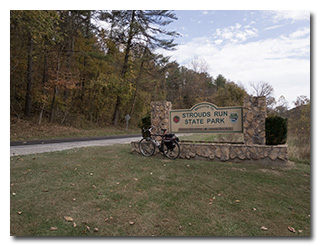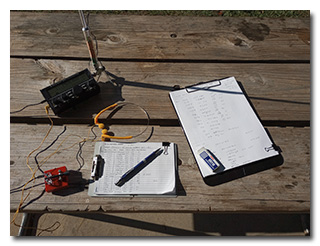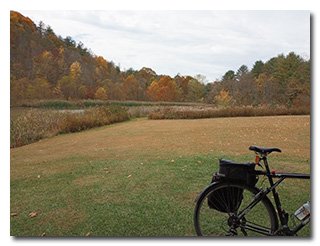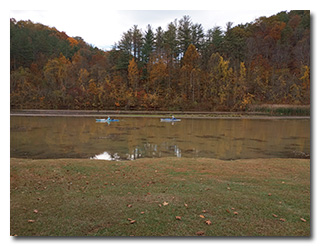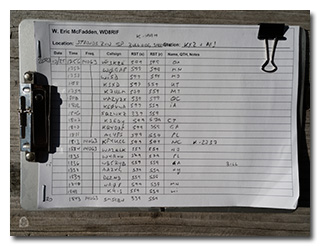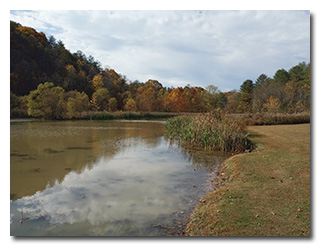
by William Eric McFadden
From the Strouds Run State Park website:
-
Strouds Run State Park is located in the scenic forested hills of Athens County, in the midst of the unglaciated Appalachian Plateau. Although untouched by the vast ice sheets that moved across portions of the state over 12,000 years ago, Strouds Run displays the effects of the glaciers -- in the deep ravines and high hills -- where the valleys served as outlets for torrents of glacial meltwaters. The erosive power of these waters carved the valleys and hillsides, creating the familiar topography Ohioans know today. Large deposits of glacial outwash, primarily sand and gravel, were deposited along these streams and strongly affected the type of biological communities present today.
Sandstone, the principal bedrock outcropping in the region, is very resistant to erosion and forms the uplands and steep sides of the valleys. Twisting roads and forest trails pass through these deep ravines and lead to dense stands of beech, hickory, oak, maple and tuliptree. Seasonal displays are offered by flowering dogwood, redbud and spring wildflowers -- with fall presenting a pageant of colorful foliage. These woods are home to white-tailed deer, fox, raccoon, opossum, squirrel, wild turkey and a variety of songbirds. Woodthrush, white-breasted nuthatch, scarlet tanager, pileated woodpecker and the rufous-sided towhee inhabit the forest canopy. These rugged hills and woodlands are truly reminiscent of the wilderness that characterized the Ohio country in the days of early settlers.
Pictures
- "Welcome to Strouds Run State Park"
- The view from Eric's operation position: 1 | 2
- Eric's KX2 / AX1 station
- Eric's log
- Dow Lake
Description
On the afternoon of October 25, 2023, one member of the Southeast Ohio Radio Adventure Team took advantage of spectacular Fall weather to perform a successful bicycle-portable activation of Strouds Run State Park (K-1994) as part of the Parks on the Air (POTA; link) program.
Taking an afternoon of paid time off, Eric McFadden, WD8RIF, bicycled from his office to Bulldog Shelter within Strouds Run State Park with his small and lightweight KX2 Mini Travel Kit for his 80th activation of the park, earning himself the Fishing Hole Repeat Offender Activator Award for Strouds Run State Park.
After earning his Bear Cave Repeat Offender Activator Award for sixty activations of Strouds Run State Park, and after having purchased his Elecraft KX2, Eric had set an informal goal of earning the Fishing Hole Repeat Offender Activator Award for eighty activations of Strouds Run State Park mainly using human-powered-transport, by bicycling to the park or by hiking within the park, with his KX2 Mini Travel Kit. Toward that end, Eric had performed two pedestrian-portable activations by hiking within Strouds Run State Park, and this activation was to be his 13th bicycle-portable activation of the park.
Eric began his ride from his office to Strouds Run State Park at 1720 UTC.
Upon reaching Bulldog Shelter at 1749 UTC, Eric found the shelter to be unoccupied. He set up his Elecraft KX2 transceiver on a shaded picnic table within the shelter and, for a change, mounted his Elecraft AX1 antenna (link) to his KX2, pulling the single 13' counterpoise wire out of the shelter and placing it on the ground. Eric was on the air at 1754 UTC.
Eric had good cell-signal and would be able to spot himself on the POTA Spots website and to use POTA Spots to identify possible Park-to-Park (P2P) QSOs.
Eric began his operation on 20m by finding a frequency to run, beginning to call "CQ POTA", and was auto-spotted to POTA Spots. His first QSO came at 1756 UTC with VE3KZE in Ontario. QSOs came quickly, with Eric's twelfth QSO coming at 1813 UTC with KF4UCC who was activating Jockey's Ridge State Park (K-2737) in the Outer Banks of North Carolina. During this run, Eric had to pause his operation in order to answer a call on the local 2m repeater, and the run included the aforementioned P2P QSO with VE3KZE, a two-fer P2P QSO with WI5D (ex-K0BWR) at Little Bean Marsh State Conservation Area (K-7863) and Lewis and Clark National Historic Trail (K-4572) in Missouri, a P2P QSO with VA2YZK at Parc regional de la Foret Drummond Regional Park (VE-4975) in Quebec, and QSOs with operators located in Poland, Ontario, Minnesota, Missouri, Utah, Montana, Quebec, Iowa, Connecticut, Georgia, Florida, and North Carolina. It was during this run that Eric discovered that the Bulldog Shelter wasn't unoccupied—it was full of annoying, biting Asian Lady Beetles—but Eric perservered, despite the discomfort.
Pausing to consult POTA Spots for P2P QSO opportunities, tried to work two activators including one in Puerto Rico, but their pile-ups were deep and Eric's 5w and 4' whip antenna weren't up to the task of breaking the pile-ups.
Switching to 17m, Eric reconfigured the AX1 antenna for this band, began calling "CQ POTA", and was auto-spotted to POTA Spots. Unfortunately, several minutes of calling failed to produce even a single response.
Returning 20m to run a frequency, Eric's first QSO in this second run came at 1834 UTC with WA2QLK in New Jersey. QSOs came quickly, with Eric's eighth QSO in this run coming at 1834 UTC with SM5CBN in Sweden. This run included QSOs with operators located in New Jersey, Florida, Georgia, New York, Germany, Minnesota, Wisconsin, and Sweden.
In all, Eric logged twenty QSOs, with four P2P QSOs, in fifty minutes of on-air time. All of Eric's QSOs were CW and were made at five watts output.
Eric took some photos, tore down his station, loaded his bicycle, and bicycled home.
Eric was impressed with how well the ridiculously-small AX1 whip antenna worked on 20m under the picnic shelter's metal-roof, and by how quickly the antenna can be deployed. This was only the second time Eric had used the AX1, and this time QSOs came much more quickly than during the previous activation.
Eric also submitted his log to the World Wide Flora and Fauna in Amateur Radio (WWFF; link) program for an activation of Strouds Run State Park, KFF-1994.
(return)
